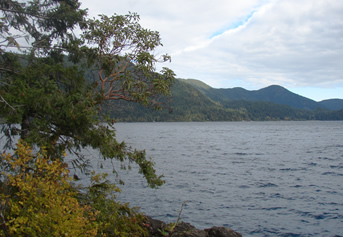Pacific Northwest broadleaf hosts
One of the major factors that will affect the potential spread of Phytophthora ramorum in western Washington forests is the ability of this exotic pathogen to sporulate on known and potential hosts within these forests. In California, the ability of P. ramorum to produce large quantities of inoculum on California bay laurel is a major factor in the epidemiology of sudden oak death in their forest ecosystems. Tanoak appears to be the most important epidemiological host associated with the spread of P. ramorum in southwestern Oregon forests. In the United Kingdom, sporulation on rhododendron within forests appears to be responsible for the spread of this pathogen to several forest trees.
Western Washington is considered to be at high-risk for the spread of P. ramorum. Limited information is available regarding the sporulation of P. ramorum on hosts in western Washington forests. Research is underway to determine the potential for P. ramorum to sporulate on known and potential hosts that commonly occur in western Washington forests. This information will increase our understanding of potentially important epidemiological hosts and provide insights on the role they may play in the spread of P. ramorum in forest ecosystems where other important epidemiological hosts, such as California bay laurel and tanoak do not occur.
Studies with known conifer hosts, such as Douglas-fir, indicate that infection occurs during the early stages of shoot emergence. Thus, sporulation on hosts such as madrone and big leaf maple which potentially have foliage within the mid to upper canopy of the forest probably pose the greatest threat to spreading the disease to established conifers. Although one small preliminary study suggests that P. ramorum does not produce sporangia on infected Douglas-fir and grand fir shoots, additional tests are needed to confirm this and determine the potential for it to sporulate on other conifer foliage within Washington’s forests. Although potentially less important as a source of inoculum for standing trees, sporulation on understory shrubs, like Pacific rhododendron and salal, may be important sources of inoculum that may contaminate logs during harvest.
A laboratory study using detached leaves of some common broadleaf hosts found in the PNW was undertaken in summer of 2009 and 2010. Leaves were inoculated with a zoospore suspension of an NA1 isolate of P. ramorum and lesion area and infection frequency was evaluated. If P. ramorum was recovered from a leaf that did not show a visible lesion, it was considered to be infected asymptomatically. Sporulation potential of foliage of each plant species was also determined.
In general, the results of this study indicate that western Washington forests are not at high risk for damage caused by P. ramorum, based on the host plants tested. However, this is a subset of the many plant species that occur, and there may be a host species that is either extremely susceptible to infection or a prolific sporulator, that was not tested in this study. Plants posing the smallest risk of P. ramorum establishment were generally invasives and/or riparian species. The highest risk plants were commonly found in forested environments. These were fairly susceptible to infection and produced more chlamydospores than sporangia in their foliage.
Chlamydospore production was higher than sporangia production on many hosts in western Washington forests that were examined in this study. In other systems, such as bay laurel (Umbellularia californica) in California, and Rhododendron ponticum in the UK, P. ramorum outbreaks are driven by high concentrations of sporangia produced on foliage of these hosts. None of the Washington hosts tested produced as many sporangia as U. californica. Chlamydospores are a means by which P. ramorum can persist on a site in soil and decaying foliage, but will probably not produce large amounts of inoculum unless they germinate directly into sporangia, which can occur in flooded soils.
Publications
Phytophthora ramorum isolated from California bay laurel inflorescences and mistletoe: possible implications relating to disease spread 174 KB
Gary A. Chastagner, Kathy Riley, and Norm Dart
Contact: Gary Chastagner, 253-445-4528 | WSU Puyallup Research & Extension Center, 2606 West Pioneer, Puyallup, WA, 98371-4998 USA
Last updated January 2, 2013
